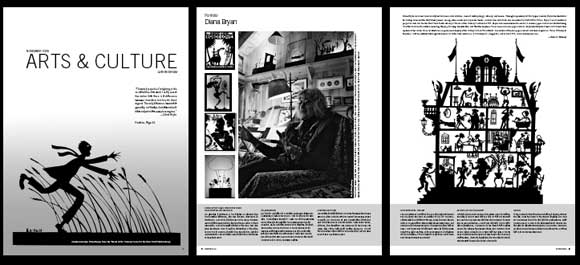Chronogram Magazine - November 2005

There is a prejudice I'm fighting in the so-called fine-arts world. I really resent the notion that there is a difference between illustration and fine art. Good is good. The only difference I see is that generally, not always, illustration should have subject matter people recognize.
-Diana Bryan
DIANA BRYAN TALKS ABOUT HER WORK
THE STORYTELLING TRADITION
I'm basically a storyteller in the tradition of Daumier and the Grünwald altarpiece, and Red Grooms-they were all storytellers. A lot of the artists hired by the Works Progress Administration were realistic and told stories. Many of them did murals. A lot of the great painters of the '30s, '40s '50s were storytellers. Then it became fashionable in the early-to mid-'50s to become abstract and you had the Abstract Expressionists. There's always been a tradition of storytelling in the gallery world.
COLLABORATION
For a year I illustrated all of William Burrough's articles for Crawdaddy. It was so much fun. I had an art director who said, "Do whatever you want." I was lucky at the beginning of my career as an illustrator to be given respect by art directors. As an illustrator, when you're targeting a market, you're either looking for money or you're looking for an ongoing relationship with someone you can collaborate with and who treats you with respect. I was very lucky to find art directors who liked my sense of humor and social conscience and let me be wildly creative.
A MUTANT ART FORM
I've created a mutant art form. I'm using the lowest technology, which is paper cutouts, with the highest technology, which is digital. I'm influenced by very sophisticated artists and very primitive ones in popular culture. I love comic books, cartoons, and animation. I've combined all the things I've loved, and I think that's what creative people do. I'm not the only paper cutout artist or silhouette artist, but my work doesn't look like anyone else's.
ILLUSTRATION VS. FINE ART
The line [between illustration and fine art] usually falls when you die, when your work is elevated to fine art. Toulouse-Lautrec was an illustrator for the sex, drugs, and rock and roll joints of his generation and he was looked down upon. But now he's in all the big museums. It helped his career that he died. I don't subscribe to that theory. When an artist is doing something really exciting, if it's reproduced in a magazine it's an illustration, if it's on a wall it's a painting. I don't think your thought process is different.
ARTISTS AND THE COMMUNITY
Artists are the luckiest people in the world. If you're creative, you have a kind of work that you can do that fills you with joy. And the ones who feel that they are supposed to suffer and be self-destructive-I don't buy into that; I think that's bad brainwashing. I subscribe to the theory that creative people are making themselves happy, and hopefully other people happy, doing a kind of work that they love. If you've been smart enough to figure out how to get paid to do your creative work, I think it's a great gift; and you have an ethical responsibility to give back to the community.
YIDDISH
At the moment I'm writing and illustrating a pseudo-Yiddish folk tale. I love the humor in the Yiddish language and I feel very depressed about the fact that it's disappearing. What I'm working on is kind of an autobiographical Yiddish folk tale with my favorite Yiddish words, like knibble. Knibble is [Bryan crumples a piece of paper in her hands] this. Anything that is all scrunched and funky.
Diana Bryan views her work as a hybrid between social activism, cultural anthropology, whimsy, and humor. Through exquisitely detailed paper cutouts, Bryan has illustrated for Rolling Stone and the Wall Street Journal, among other media and corporate clients, and has won awards for her animation for Rabbit Ears Video. Bryan's most ambitious project to date was for the New York Public Library's "Books of the Century" exhibit in 1995. Bryan was commissioned to create 13 massive paper cutout murals illustrating 50 of the books in the exhibit, including The Joy of Cooking, Invisible Man, and The Metamorphosis. From these and other paper cutouts, Bryan has fabricated laser-cut stainless steel replicas of her work, three of which are on permanent display at the Colony Café in Woodstock. A selection of Bryan's paper cutouts and steel sculptures, "From Whimsy to Macabre," will be exhibited through November 10 at the Café with Love, 85 Partition St., Saugerties. (845) 246-1795; www.dianabryan.com.
-Brian K. Mahoney